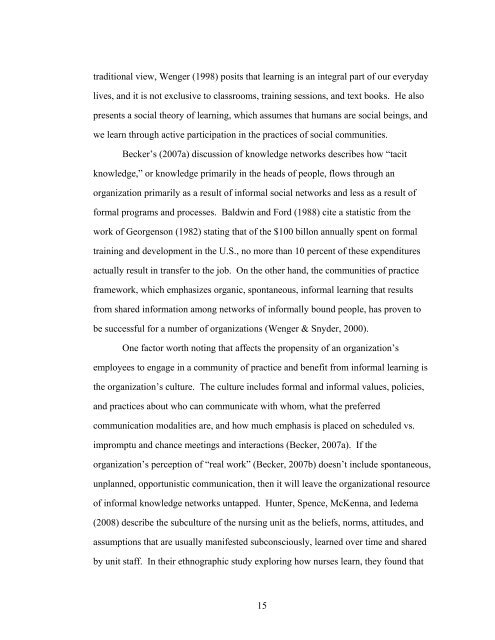The role of physical design and informal communication
The role of physical design and informal communication
The role of physical design and informal communication
Create successful ePaper yourself
Turn your PDF publications into a flip-book with our unique Google optimized e-Paper software.
traditional view, Wenger (1998) posits that learning is an integral part <strong>of</strong> our everyday<br />
lives, <strong>and</strong> it is not exclusive to classrooms, training sessions, <strong>and</strong> text books. He also<br />
presents a social theory <strong>of</strong> learning, which assumes that humans are social beings, <strong>and</strong><br />
we learn through active participation in the practices <strong>of</strong> social communities.<br />
Becker’s (2007a) discussion <strong>of</strong> knowledge networks describes how “tacit<br />
knowledge,” or knowledge primarily in the heads <strong>of</strong> people, flows through an<br />
organization primarily as a result <strong>of</strong> <strong>informal</strong> social networks <strong>and</strong> less as a result <strong>of</strong><br />
formal programs <strong>and</strong> processes. Baldwin <strong>and</strong> Ford (1988) cite a statistic from the<br />
work <strong>of</strong> Georgenson (1982) stating that <strong>of</strong> the $100 billon annually spent on formal<br />
training <strong>and</strong> development in the U.S., no more than 10 percent <strong>of</strong> these expenditures<br />
actually result in transfer to the job. On the other h<strong>and</strong>, the communities <strong>of</strong> practice<br />
framework, which emphasizes organic, spontaneous, <strong>informal</strong> learning that results<br />
from shared information among networks <strong>of</strong> <strong>informal</strong>ly bound people, has proven to<br />
be successful for a number <strong>of</strong> organizations (Wenger & Snyder, 2000).<br />
One factor worth noting that affects the propensity <strong>of</strong> an organization’s<br />
employees to engage in a community <strong>of</strong> practice <strong>and</strong> benefit from <strong>informal</strong> learning is<br />
the organization’s culture. <strong>The</strong> culture includes formal <strong>and</strong> <strong>informal</strong> values, policies,<br />
<strong>and</strong> practices about who can communicate with whom, what the preferred<br />
<strong>communication</strong> modalities are, <strong>and</strong> how much emphasis is placed on scheduled vs.<br />
impromptu <strong>and</strong> chance meetings <strong>and</strong> interactions (Becker, 2007a). If the<br />
organization’s perception <strong>of</strong> “real work” (Becker, 2007b) doesn’t include spontaneous,<br />
unplanned, opportunistic <strong>communication</strong>, then it will leave the organizational resource<br />
<strong>of</strong> <strong>informal</strong> knowledge networks untapped. Hunter, Spence, McKenna, <strong>and</strong> Iedema<br />
(2008) describe the subculture <strong>of</strong> the nursing unit as the beliefs, norms, attitudes, <strong>and</strong><br />
assumptions that are usually manifested subconsciously, learned over time <strong>and</strong> shared<br />
by unit staff. In their ethnographic study exploring how nurses learn, they found that<br />
15







